Table of Contents
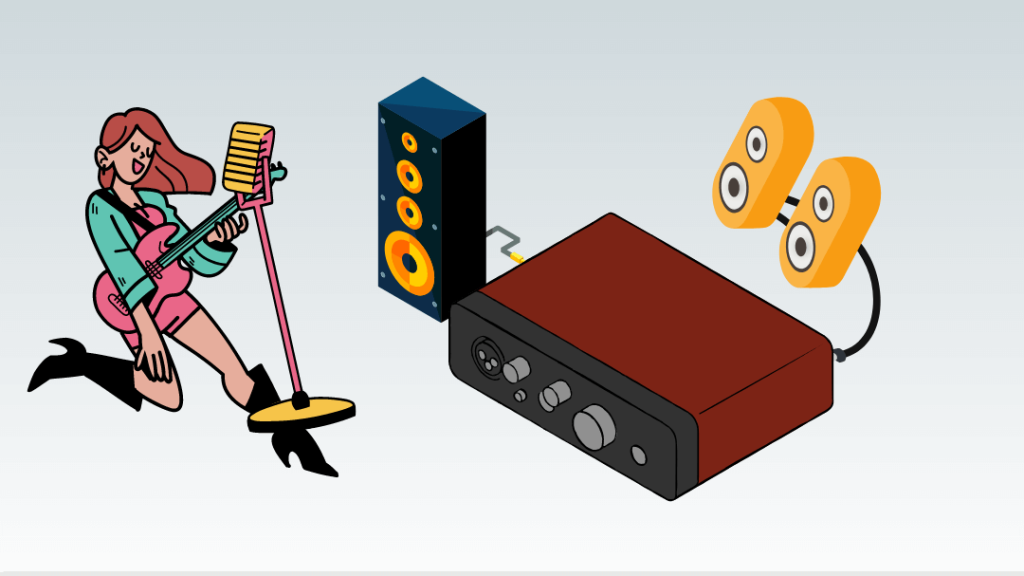
If you are into music production or just looking to record simple audio for your podcast, having a decent audio interface device will take you places.
The quality of output audio from all the devices is majorly dependent on the quality of the interface that you are using. As a result, you should ensure that the quality of the interface you are using is the best.
Other things like the number of inputs or the types of devices to be connected will also play a significant role in selecting the audio interface for you.
For this very reason, we have compiled a list of interfaces that are considered as best in the market. But, on the other hand, we have also included a guide in which you will learn how exactly to go ahead and choose the best interface for yourself.
The 10 Best Audio Interfaces
-
Focusrite Scarlett Solo Audio Interface
Product Dimensions: 3.77 x 5.65 x 1.71 inches.
Connectivity Technology: USB Type-C.
Positive: Includes 2 Low Noise Outputs, Provide A Switchable Air Mode, Easy To Start.
Negative: Mic Doesn’t Work.
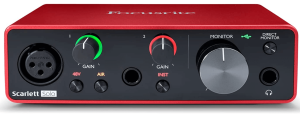 Every artist wants their instruments to sound as good as possible when recording music. That’s why it’s essential to be equipped with the right tools – and the Focusrite Scarlett Solo Audio Interface is just that. It is easy to get professional-quality recordings with its switchable Air mode that adds extra clarity to your vocals.
Every artist wants their instruments to sound as good as possible when recording music. That’s why it’s essential to be equipped with the right tools – and the Focusrite Scarlett Solo Audio Interface is just that. It is easy to get professional-quality recordings with its switchable Air mode that adds extra clarity to your vocals.
Its low-noise balanced outputs ensure you get clean audio playback, ensuring that everything is coming through ideally when recording. Its gain halos enable users to capture their instruments in all their glory without any unwanted clipping or distortion. Plus, with its three-year warranty included, you can be confident that the hardware will provide performance and reliability throughout those years.
Customer Review For Focusrite Scarlett Solo Audio Interface
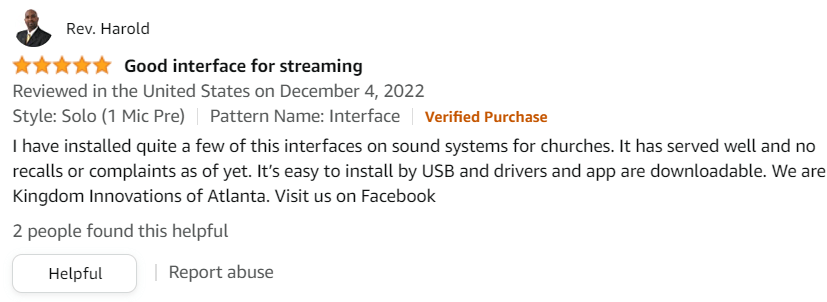
-
Audient iD14 Audio Interface
Product Dimensions: 5.91 x 4.72 x 1.77 inches.
Connectivity Technology: USB.
Positive: Features 8-channel Adat Input, Burr-Brown Converters, Includes 2 Mic.
Negative: Needs To Improve Customer Service.
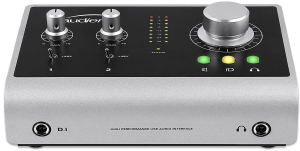 The versatile and intuitive Audient iD14 Audio Interface is ideal for digital audio creators looking to make their home recording studio sound professional. Users can access digital technology with its 10-in/4-out USB desktop audio interface and Burr-Brown converters. You can also connect studio headphones to this interface easily.
The versatile and intuitive Audient iD14 Audio Interface is ideal for digital audio creators looking to make their home recording studio sound professional. Users can access digital technology with its 10-in/4-out USB desktop audio interface and Burr-Brown converters. You can also connect studio headphones to this interface easily.
At the same time, they are achieving high-quality analog recordings courtesy of its two-class mic preamps. What’s more, there’s an 8-channel ADAT input and a JFET DI providing further flexibility should you need it. The Audient iD14 Audio Interface makes it easy to produce outstanding recordings with a plug-and-play setup.
Customer Review For Audient iD14 Audio Interface

-
Apogee Duet 3 Audio Interface
Product Dimensions: 10 x 7 x 3 inches.
Connectivity Technology: USB.
Positive: Compatible With All Devices, Includes Scratch-resistant Cover Glass, Ultra-compact Design.
Negative: No Volume Indicator Included.
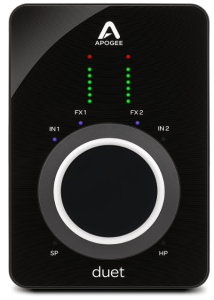 The Apogee Duet 3 Audio Interface is a remarkable technology perfect for both in-studio and mobile recording sessions. It provides up to 65 decibels (dB) gain with 48 volts (V) of phantom power, enabling it to capture any audio source with unparalleled clarity. It is also incredibly compact and easy to transport due to its scratch-resistant cover glass.
The Apogee Duet 3 Audio Interface is a remarkable technology perfect for both in-studio and mobile recording sessions. It provides up to 65 decibels (dB) gain with 48 volts (V) of phantom power, enabling it to capture any audio source with unparalleled clarity. It is also incredibly compact and easy to transport due to its scratch-resistant cover glass.
Additionally, the Symphony ECS channel strip allows users to optimize their recordings to get maximum audio quality in every recording session. It’s powered through a USB connection without sacrificing audio quality. It makes it compatible with macOS, Windows 10, and iOS devices like an iPhone or iPad.
Customer Review For Apogee Duet 3 Audio Interface

-
Focusrite Scarlett 4i4 Audio Interface
Product Dimensions: 4.72 x 7.28 x 1.87 inches.
Connectivity Technology: USB Type-C.
Positive: Includes Four Balanced Line Inputs, Easy To Start, 3-year Warranty Available.
Negative: Difficult To Set-up.
 The Focusrite Scarlett 4i4 Audio Interface is ideal for music production and recording. Equipped with two of the finest mic preamps and Air mode, you can add clarity to your acoustic instruments and vocal performances. Additionally, this interface offers balanced four-line inputs and outputs for connecting synthesizers or line-level audio.
The Focusrite Scarlett 4i4 Audio Interface is ideal for music production and recording. Equipped with two of the finest mic preamps and Air mode, you can add clarity to your acoustic instruments and vocal performances. Additionally, this interface offers balanced four-line inputs and outputs for connecting synthesizers or line-level audio.
The class-leading drivers ensure low latency, so you capture sound without delay. It also features Antares Auto-Tune Access that allows natural-sounding vocals and is a breeze to set up. And thanks to the 3-year warranty, it’s one purchase that will have a long-lasting impact on your productions.
Customer Review For Focusrite Scarlett 4i4 Audio Interface

-
Donner USB Audio Interface
Product Dimensions: 5.87 x 3.35 x 1.93 inches.
Connectivity Technology: USB.
Positive: Easy To Port, Provide Wide Compatibility, Easy To Set-up.
Negative: Limited Functionality.
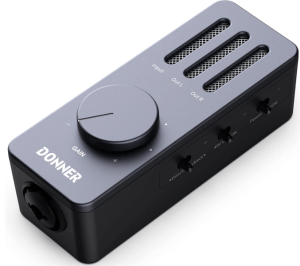 With the Donner Audio Interface, musicians can experience studio-quality sound no matter where they perform. It features an XLR connector which enables professional condenser microphones and type-C and Apple adapters to connect directly to phones and tablets.
With the Donner Audio Interface, musicians can experience studio-quality sound no matter where they perform. It features an XLR connector which enables professional condenser microphones and type-C and Apple adapters to connect directly to phones and tablets.
Additionally, its digital guitar interface is designed with knobs for better monitoring and a separate volume control for optimal sound alteration. Plus, its built-in battery provides both conveniences for outdoor live streaming and portability so any musician can take their rig on the go.
Customer Review For Donner USB Audio Interface

-
LVY 2In-2Out USB Audio Interface
Product Dimensions: 5.5 x 3.4 x 1.4 inches.
Connectivity Technology: USB.
Positive: Compact Design, Monitor Directly Through The Preamp Input, Accept Both XLR And Jacks.
Negative: No ASIO Support.
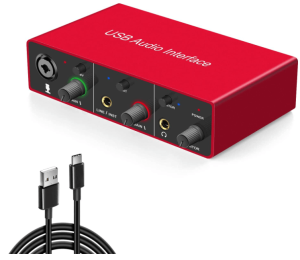 If you’re looking for a comprehensive audio interface solution, the LVY 2In-2Out USB Audio Interface provides an ideal package. You can easily connect lavalier microphone for recording the voice, guitars, and other instruments through its XLR and 1/4″ jacks. You can easily link to powered studio monitors with two TRS jack sockets on both the left and right.
If you’re looking for a comprehensive audio interface solution, the LVY 2In-2Out USB Audio Interface provides an ideal package. You can easily connect lavalier microphone for recording the voice, guitars, and other instruments through its XLR and 1/4″ jacks. You can easily link to powered studio monitors with two TRS jack sockets on both the left and right.
Additionally, the interface comes with 48V phantom power in the XLR socket, making it even more versatile. To top it all off, it uniquely powers itself via a Type C port while simultaneously transmitting data.
Customer Review For LVY 2In-2Out USB Audio Interface

-
iConnectivity Audio And MIDI Interface
Product Dimensions: 11 x 9.7 x 3.25 inches.
Connectivity Technology: USB.
Positive: Connect 2 Computers, Includes Touchscreen LCD, Provide Footswitch Input.
Negative: A Bit Expensive.
![]() The iConnectivity Audio and MIDI Interface is the perfect tool for any music production enthusiast! It lets users connect two computers simultaneously and features a maximum resolution of 24-bit/96 kHz.
The iConnectivity Audio and MIDI Interface is the perfect tool for any music production enthusiast! It lets users connect two computers simultaneously and features a maximum resolution of 24-bit/96 kHz.
With outstanding 10 x 1/4″ TRS balanced outputs, 1/4″ TRS stereo headphone output. Thanks to the touchscreen LCD and footswitch input, it gives you more time to work on creating unique live sets.
Customer Review For iConnectivity Audio And MIDI Interface
-
Apogee Boom USB Audio Interface
Product Dimensions: 7.48 x 9.49 x 2.91 inches.
Connectivity Technology: USB.
Positive: Features Premium AD/DA Components, Including Symphony ECS Channel Strip, Provide 2 Quality Inputs.
Negative: A Bit Expensive.
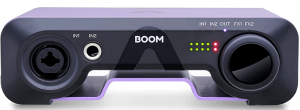 The Apogee Boom USB Audio Interface features premium AD/DA components and sample rates up to 24bit/192kHz, making it an excellent choice for any recording situation. It comes with the Symphony ECS Channel strip, which includes a 3-Band EQ, compressor and saturator to give your recordings a professional sound.
The Apogee Boom USB Audio Interface features premium AD/DA components and sample rates up to 24bit/192kHz, making it an excellent choice for any recording situation. It comes with the Symphony ECS Channel strip, which includes a 3-Band EQ, compressor and saturator to give your recordings a professional sound.
Additionally, this interface offers two studio-quality inputs and two outputs — enough high-quality audio I/O for many setups. You can also rest assured that you’ll get all the clean, noiseless gain you need to power any mic without fail. Lastly, it is compatible with any iOS device, making this an incredibly user-friendly piece of equipment for smartphone users looking to get into production.
Customer Review For Apogee Boom USB Audio Interface

-
Universal Audio Apollo Interface
Product Dimensions: 9 x 9 x 6 inches.
Connectivity Technology: XLR.
Positive: Comes With 5 Plug-in Titles, Provide Near-zero Latency, Gives Low-noise Monitoring.
Negative: Quality Is Questionable.
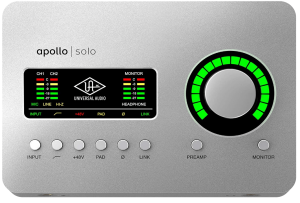 Music producers looking to improve their sound recording setup may be interested in the Universal Audio Apollo Interface due to its comprehensive suite of 5 award-winning plug-in titles.
Music producers looking to improve their sound recording setup may be interested in the Universal Audio Apollo Interface due to its comprehensive suite of 5 award-winning plug-in titles.
It produces a fully-integrated recording application and is also compatible with popular music editing software such as Logic Pro, Pro Tools, Cubase and Ableton Live. Further still, the interface includes a headphone amplifier that allows loud but low-noise monitoring so that production engineers can accurately listen to what they are creating.
Customer Review For Universal Audio Apollo Interface

-
UA Volt 1 USB Audio Interface
Product Dimensions: 5.12 x 5.71 x 1.97 inches.
Connectivity Technology: USB 2.0.
Positive: Provide High-quality Audio Conversion, Features Latency-free Recording, and Includes Vintage Mic Preamp Mode.
Negative: A Bit Difficult To Install.
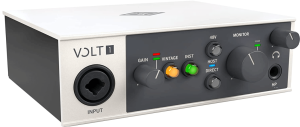 The UA Volt 1 USB Audio Interface makes music production, live streams, and podcasts incredibly easy with its powerful features. Its Vintage Mic Preamp mode lets you record vocals and instruments with beautiful, pristine sound quality due to the 24-bit/192 kHz audio conversion.
The UA Volt 1 USB Audio Interface makes music production, live streams, and podcasts incredibly easy with its powerful features. Its Vintage Mic Preamp mode lets you record vocals and instruments with beautiful, pristine sound quality due to the 24-bit/192 kHz audio conversion.
Additionally, with MIDI connections and 48V phantom power, you can be sure that any sound is saved with the best quality. It comes with direct monitoring for latency-free recording, so you don’t have to worry about having an awkward echo or delay.
Customer Review For UA Volt 1 USB Audio Interface
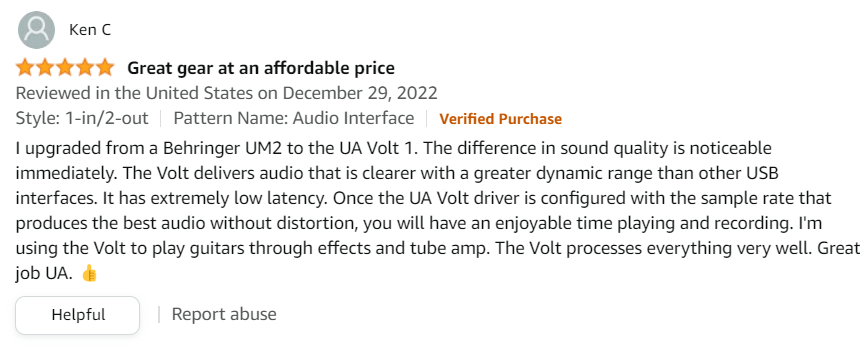
What Is An Audio Interface?
An audio interface is an external device or external hardware that could assist in connecting your guitars, keyboards, microphones, or other audio sources to your operators or computers.
They could connect and work both ways by converting analog signals into digital forms and digital signals into analog formats.
An audio interface is a favored middleman that acts as a pleasant bridge between your audio devices, including your microphones, and the system you desire to connect them to.
There are several options to choose from when you look for an audio interface. For example, there could be an option for USB connectors or PCI connections.
These audio interface devices could ease your workload to a great extent. However, they are available in distinct sizes, and their prices could also vary.
Knowing details about an audio interface would naturally mean how well you could sync in your audio and instruments to make the perfect outcome of all the hard work you have done for your studio.
The recording could be done using any device, and you could enhance its sound quality using high standards tablets or smartphones.
But, if you’re serious about developing the best recording tape or audio with the premium or professional level of recording, you should consider investing in a good quality audio interface.
Do You Need An Audio Interface?
You could require an audio interface if you wish to record music or a podcast with the help of digital software on your computer through microphones.
An audio interface is needed if you wish to connect different devices, such as microphones, speakers, and electronic instruments.
Apart from connecting your devices to your computer, a good quality audio interface could also help in upgrading the sound quality and your overall music recording experience as it would enhance each instrument’s music separately but in perfect harmony.
The need for an audio interface could be well understood because it could easily connect the analog world to the digital setup on the laptop or computer.
You might as well need an audio interface to develop electronic music as it improves audio quality, which is a must for a professional level of music recording.
These balanced-out connectors or audio interfaces may be needed for studio monitors as the accuracy is somewhat lacking in primary electronic devices.
How Many Inputs And Outputs Do I Need?
The I/O count could improve the overall experience of using an audio interface for developing audio pieces.
Simple setups or standard audio interfaces could have 1 or 2 input/output counts, which could be considered perfect for recording for a small audio project.
On the contrary, the input/output count could go up in numbers more than 19 or 20 and above when a more professional audio interface has been used to connect to digital devices.
How many counts of input/output you require could depend on how many tracks you wish to record or what number of ways you will monitor by controlling the audio interface.
- An Input/Output between 2 and 4 is ideal for a solo singer or a music artist.
- An input/output between 4 and 8 could be preferred for a music band or a person recruited to work with a team.
- On the other hand, if you are just recording the podcast, then you may require only a couple of mic inputs and digital output points to connect to your computer to save the audio.
- The more professional ones, like audio engineers, might require more than 18 inputs/output as they have to work with an entire music band.
What Types Of Inputs And Outputs Do I Need?
There is a variety of audio interfaces available and there could be people who might want them for their specific purposes like for a live recording, or when they are just starting as an audio engineer.
Different audio interfaces connect differently to your laptop or computers they could or could not be a better option for you.
Depending on their connectivity, types of knobs and controls, and most importantly their types of inputs/ outputs, an audio interface could differ.
The lesser the number of inputs/outputs involves, the smaller and easier to carry around an audio interface will be.
On the other hand, more numbers and types of input/out would mean a more stable and stationary setup of an audio interface will be.
Additionally, an increased number of inputs/outputs in an audio interface could also depict that it would have a more functional setup that would also be different from each other.
They could vary in terms of speaker output setup, or some might be added for different instruments through cables, headphones, microphone outputs, and so on.
-
Standard Inputs
Microphone: It is the basic requirement for connecting the microphone through microphone cable input.
Line Input/Direct Injection: These standard inputs are required for connecting electric guitars or other electrical instruments.
MIDI: MIDI or musical instrument digital interface, could be required as standard input for electronic drum sets and other instruments with the computer.
-
Standard Outputs
TRS: The standard output cable preferred in an audio interface could be TRS which could attempt to connect different stereo channels.
RCA: An RCA cable could have three different colors that are used as standard output for different signals. It could connect the left speaker audio and right speaker audio through those different colors of wires dedicated for specific purposes.
XLR Output: It is common in amplifiers or DJ mixers and is available in microphones and various other audio devices. These standard outputs have a three-pin connector that may make them different from other types of outputs.
Features Worth Considering When Looking At Audio Interfaces
Getting an audio interface for sound recording or setting up your studio could be an essential investment. This is because connecting your microphones, headphones, speakers, and various instruments would be the focal point.
Thus, having the appropriate audio interface for your studio or your personal use could be the true ace of a spade for your dream studio setup.
Thus, here are a few features to consider when looking for an audio interface –
-
Budget
While examining an audio interface, its budget and what specific features it could offer at a certain price should be considered.
You may want the premium quality audio interface at a reasonable price while also looking for the best and the highest quality possible for your microphone and overall setup.
But, even if you wish to restrict yourself from spending extra on your audio interface, you may ruin your recording experience in terms of quality.
Even with a high-quality microphone and speakers, a sub-standard audio interface could deliver below-average sound quality with excessive distortion and disturbance in the background.
Thus, your decision to buy an audio interface should be future-oriented, and there shouldn’t be any shortcuts while purchasing an audio interface, as a bit of overspending on them could go a long and may help you save on additional costs arising from services in the future.
-
I/O
One of the basic yet essential features to look out for is whether your audio interface has the exact input/out setup you require.
If you have a large studio setup and the work relies on outboard effects, you should look for an audio interface with several input-output settings.
On the other hand, if you wish to buy an audio interface for your personal use, then just a single setup for a microphone and musical instrument is enough for you to get started.
Additionally, an audio interface diversifies your perspective while developing music, so you could look for a setup with extra input/output access, as it could add to your preliminary design and modify it by adding more audio or good connectivity options.
-
Compatibility
Most audio interface models could be compatible with a digital audio workstation of DAW, but they might be some instances where this could not be possible.
While looking for an audio interface, you should also check for compatibility. For example, they must be able to be connected to your computer through connectors.
Various options are available for audio interfaces in the market or online stores. There could be ones that do not require an additional power supply and could function through USB.
On the other hand, the compatibility of an audio interface could also be known through its ability to connect to the computer through interface connectors-
Thunderbolt: It may offer faster speed along with reduced latency levels and may also be able to support longer optical cables that could support a more extensive studio setup.
USB: It is one of the most common audio interface connectors and may be helpful when you are recording using a laptop and is also portable.
Firewire: An advanced version of a USB, a firewire has an increased transfer rate and is considered more reliable than the USB port. Though they are not commonly opted for because of the versatility that USBs offer.
Thus, the audio interface could’ve different compatibility levels, depending on the interface connectors selected as per a person’s need or purpose.
-
Preamp Quality
High-quality audio interfaces come up with premium preamp quality features that could help deliver better sound quality.
There are built-in preamps available in audio interfaces, but their quality could vary greatly. Thus, while looking for an audio interface, you must check for the preamp quality before buying them.
The high-end audio interface could have precisely manufactured preamps with various components that may also constitute it.
These preamps are made to enhance low audio signals like the ones coming from a microphone, which may otherwise be not appropriately delivered and are somewhat distorted without a proper preamp.
They are also called preamplifiers that may also strengthen the audio signals so that they may work efficiently.
A preamp could develop a minuscule signal, which is carried for further processing and sending to the audio chain to elevate sound output levels and overall quality.
Hence, it would help if you ensured that your audio interface had a decent preamp. Otherwise, there are high chances that you may face distortion issues and an absence of background voice clearance in the resulting or final audio.
Final Thoughts
As you might have already understood, there are many factors to consider while choosing the perfect audio interface. This guide about best audio interfaces might have helped you gain enough information to make an informed buying decision.
Choosing a decent audio interface should never be lower on your priority list. This is because the audio interface could level up your music recording procedure as you could control audio coming from instruments and songs and channel them perfectly per the requirements.
Frequently Asked Questions/FAQs
Technically considered a sound card, an audio interface is much better than a sound card as it has added qualities and more inputs and outputs. Audio interfaces also have reduced interference and distortion compared to sound cards and have more phantom power than good cards.
The latest audio interface can connect to your computer using a USB or thunderbolt port. The classic older version of the audio interface was connected using ethernet or PCIe. They might work on windows and apple IOS-based electronic devices, but the functioning lies on an added adaptor which could be needed for connecting them to the audio interface.
An audio interface with more input for a music band should always be preferred. This is because they wish to record every sound from various instruments on different tracks. However, they might try choosing an audio interface that could record the main outs alone, but that would eliminate the single mixing of each singer or player.
Connecting an audio interface could improve audio quality by giving you easy access to improved audio quality adjustments more than what you already have on your laptop or computer. These perks might include an efficient sample rate and improved DAC conversion rate while also managing the output and amplifiers.
Yes, it is okay to detach the audio interface after you are done using it, but it should be noted to do so after turning off the computer to make sure that no apps are still utilizing it and that you are safe from causing any issues.